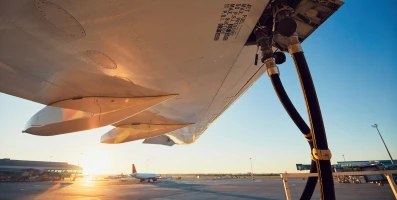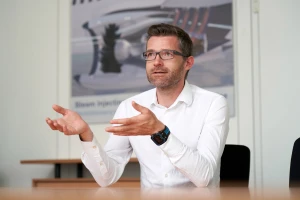innovation
Cleaner flight: Europe explores paths to climate-neutral air travel
Achieving climate-neutral air travel by 2050 would mean we can continue to fly with a clear conscience. Researchers are working hard to make this happen.
author: Patrick Hoeveler | 7 mins reading time published on: 23.10.2023
author:
Patrick Hoeveler
is a freelance aviation journalist working for FLUG REVUE and other publications.
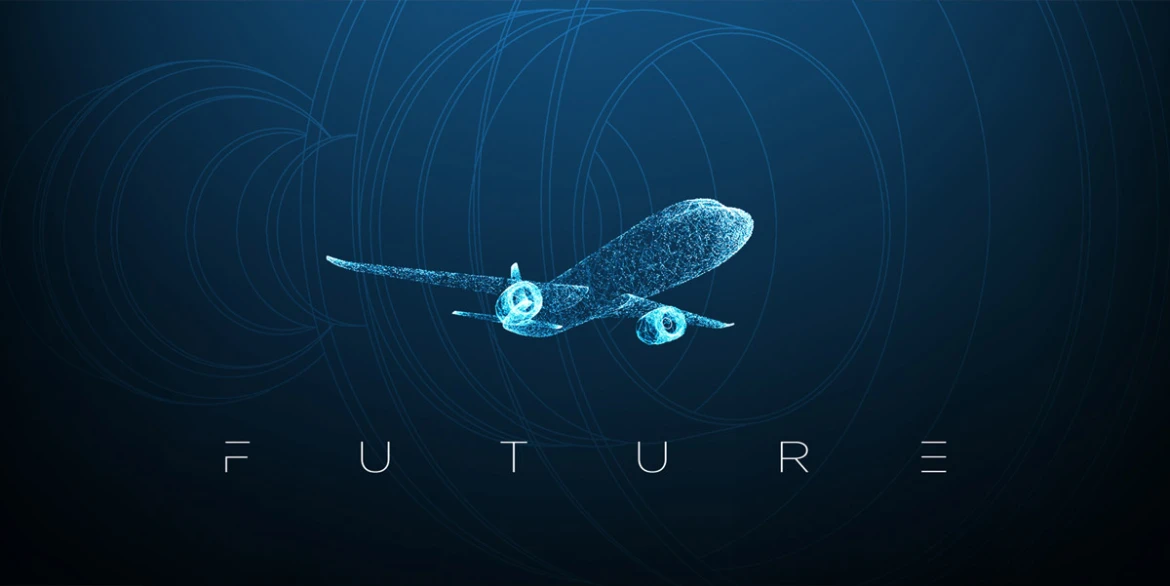


Disruptive new technologies: The Clean Aviation Joint Undertaking is the European Union’s leading research and innovation program for transforming aviation toward a sustainable and climate‑neutral future. It will develop disruptive new aircraft technologies to support the European Green Deal, and climate neutrality by 2050. These technologies will deliver net greenhouse gas reductions of no less than 30 percent, compared to the 2020 state of the art. The program is built on three main pillars, each with demonstration efforts driving the energy efficiency and the emissions reduction. Clean Aviation is to receive EUR 1.7 billion in funding. It is embedded in the EU’s Horizon Europe framework program.
With refueling complete, the crew of the narrowbody jet can start preparing for takeoff. At the same time, a turboprop airliner lands and taxis to its place on the apron without any of the typical noise. This is because it’s powered by fuel-cell electric motors. Welcome to life at a commercial airport in the year 2050—a place completely devoid of climate-damaging emissions. According to the European Union, this vision could become reality within just a few decades: the EU Green Deal aims to achieve zero net greenhouse gas emissions by 2050 and thus make Europe the first climate-neutral continent.
“This is the most ambitious legislation ever passed to enshrine climate neutrality, which makes the European Commission and the European Union pioneers,” says Gunnar Klaus, Representative for International Technology Collaborations and Demonstrator Programs at MTU Aero Engines. But although achieving these ambitious targets is still a fair way off, in the aviation sector, the EU’s Clean Aviation research program ought to significantly speed up developments. Established in 2021, this joint undertaking brings together 27 founding members and additional partners from industry, academia, and research and is being funded by the EU to the tune of 1.7 billion euros.
Launched in 2021, the project's main objective is to deliver technologies that will enable aircraft to be launched from 2035 with net greenhouse gas emissions more than 30 per cent lower than those of the latest generation of state-of-the-art aircraft from 2020. In contrast to its predecessor program Clean Sky 2, which centered around advancing evolutionary technologies, Clean Aviation focuses on novel concepts that promise a quantum leap in climate neutrality.
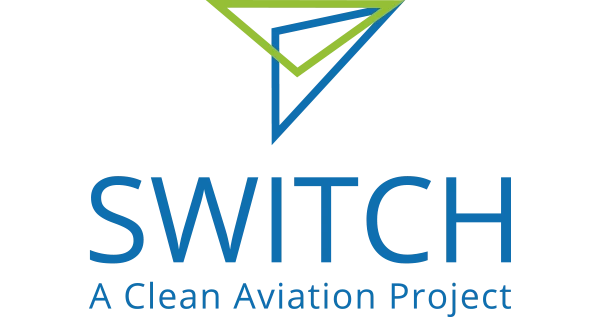

Emissions-free flight in sight: SWITCH (Sustainable Water-Injecting Turbofan Comprising Hybrid-Electrics) is a project to advance hybrid-electric and Water-Enhanced Turbofan (WET) technologies. The project focuses on combining two revolutionary technologies: MTU’s WET concept, and hybrid-electric propulsion system components. The SWITCH concept aims to significantly enhance efficiency and substantially reduce emissions across the full operating envelope of an aircraft. These new technologies are also suitable for operation with sustainable aviation fuels (SAF). The future use of hydrogen as an energy source continues to be evaluated.

Three pillars for green flying
In its strategic research and innovation agenda (SRIA), the Clean Aviation Joint Undertaking has defined its three main pillars: The first focuses on regional aircraft powered either by hybrid or fully electric propulsion systems. The second concerns the designs for most efficient narrowbody aircraft with up to 200 seats. Here, combining innovative design with extremely energy-efficient and highly integrated engines is expected to lead to drastic reductions in fuel consumption at the overall system level. The third covers disruptive technologies, which are chiefly concerned with tapping the potential of using liquid hydrogen as a fuel to power future aircraft. “This is clearly heading in the direction of zero-emission propulsion systems,” Klaus explains. “Some of the technologies we’re dealing with as part of Clean Aviation were originally intended to be addressed through our Technology Roadmap for 2040 or in subsequent years.” However, the European Commission wants to bring these pioneering technologies forward by at least a decade so that they can be tested and rolled out as soon as possible.
MTU is involved in two of these three pillars. It leads a consortium overseeing the Sustainable Water-Injecting Turbofan Comprising Hybrid-Electrics (SWITCH) project, which is attached to the second pillar and is about combining tried-and-true technologies with new approaches. This work is based on the GTF™ engine as well as on the insights gained during Clean Sky 2 that were channeled into optimizing the compressor and the turbine. The GTF is receiving not one but two upgrades. First, MTU’s Water-Enhanced Turbofan (WET) concept allows for residual heat from the engine’s exhaust gas stream to be used to significantly reduce fuel consumption, CO2 and NOX emissions, and the formation of contrails. Second, the consortium partners are developing a hybrid-electric version of the engine, which will be more efficient.
“We think that this concept, in combination with a sufficiently optimized airframe, has the potential to achieve the desired fuel savings of 30 percent. Moreover, it will let us make a noticeable reduction in climate impact,” Klaus says. Christoph Niebling, Program Director for Clean Aviation / SWITCH at MTU, adds: “There’s no doubt that these technologies are disruptive. We estimate that pursuing the evolutionary development of the previous generations of our products would yield maximum fuel savings of 10 percent.” Integrating WET and hybrid-electric technology into a propulsion concept is a great deal more complicated, he says. “Timing is the major challenge. Clean Aviation is determined to demonstrate technological maturity by 2030 so that new products can be brought to market starting in 2035. That’s a tall order because we’re still working with a basic version of this technology. But that means it has all the more potential.”
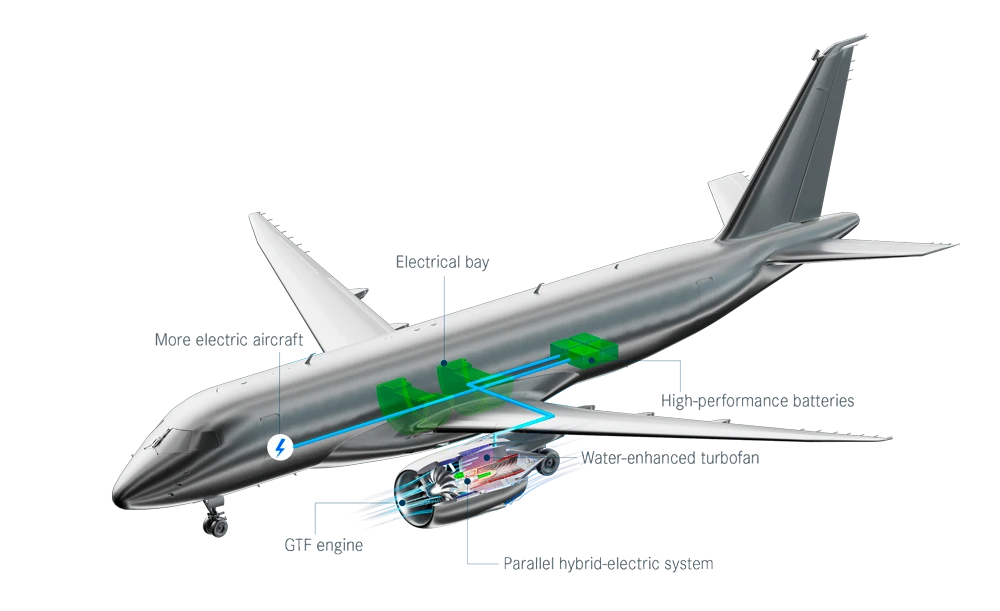
Hybrid-electric and Water-Enhanced Turbofan technologies: SWITCH combines two technologies: MTU's Water-Enhanced Turbofan concept (WET) and hybrid-electric propulsion elements. The basis is Pratt & Whitney's GTFTM engine.
Regional aircraft featuring fuel cells
As regards the third Clean Aviation pillar, MTU is focusing on the use of a fuel cell as part of the electric propulsion system for regional aircraft with 50 to 70 seats. These efforts are benefiting from a joint project between the German Aerospace Center (DLR) and MTU that aims to test such a system on a Dornier 228 during flight. As part of the Clean Aviation program, the Hydrogen-Electric Zero Emission Propulsion System (HEROPS) project is attempting to prove that the 600 kW system intended for the Flying Fuel CellTM (FFC) can also be scaled up for an application in the multi-megawatt range. “Although the Dornier 228 test is running entirely separately, the groundwork being done for that project will surely provide valuable insights for system and line development for HEROPS. It’ll then be possible to scale up the propulsion system,” Klaus explains.
The timelines for HEROPS and SWITCH are running virtually in parallel. Phase 1 of Clean Aviation—technology development—will run until 2025 and conclude with an assessment by the review board, which will select the most promising technologies. These will proceed into Phase 2—demonstration—ideally with a view to testing overall systems by 2030. “Progress hinges on proving that the technologies developed have reached maturity and have a chance of being implemented,” Klaus says.
“Clean Aviation is also in good company internationally,” Klaus adds. On the other side of the Atlantic, the U.S. aviation industry continues to search for ways to make air travel more climate-friendly, including through the Continuous Lower Energy, Emissions, and Noise (CLEEN) program, which was launched by the Federal Aviation Administration (FAA) in 2010. The U.S. government funded the first two phases of CLEEN with 225 million dollars over ten years. Preparations are currently underway for the fourth phase, which is scheduled to begin in 2025 and will also focus heavily on product applications.
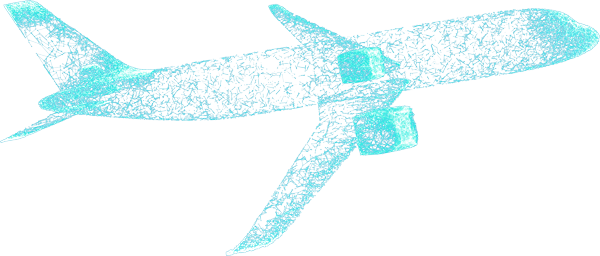
“Burning hydrogen doesn’t produce carbon dioxide, but rather water vapor and—depending on the combustor—also nitrogen oxide emissions. As a fuel, hydrogen is carbon neutral, but it doesn’t count as climate neutral unless this water vapor is released somewhere other than the lower stratosphere, and the nitrogen oxide emissions are reduced to zero. And the hydrogen must of course be produced using green electricity.”
Deputy Director of the Institute of Air Transport at DLR
Global challenges
Not all the global challenges, however, are related to technology. After all, demand for air travel is not going down. In fact, quite the opposite is true: “It’s conceivable that by 2050, the volume of air traffic will be three times what it is today,” says Florian Linke, Deputy Director of the Institute of Air Transport at DLR. What’s more, new technologies will require extensive new infrastructure. Hydrogen alone would require entirely new tank systems, as it must be cooled to around minus 250 degrees Celsius. “Right now, everywhere is set up for kerosene, but this hydrogen infrastructure would have to be installed at every airport from scratch. Besides, air travel is a global phenomenon. Even if airports here in Germany had the required infrastructure, destination airports in other countries would also need it to allow aircraft to refuel for the return journey. This means that for the whole thing to work, the rollout would have to be global,” Linke says.
In addition, the hydrogen used would have to be produced in a sustainable way. Aviation would be competing with other players in the transport sector and with industry. Linke also highlights the non-CO2 effects of aviation, like other emissions and the formation of contrails: “Burning hydrogen doesn’t produce carbon dioxide, but rather water vapor and—depending on the combustor—also nitrogen oxide emissions. As a fuel, hydrogen is carbon neutral, but it doesn’t count as climate neutral unless this water vapor is released somewhere other than the lower stratosphere, and the nitrogen oxide emissions are reduced to zero. And the hydrogen must of course be produced using green electricity.” This last point is an essential part of the future of aviation.
New aircraft in the skies
Electric unmanned air systems (UASs) also offer a vast array of potential applications – they are intended to ease congestion on the roads in the future. These range from the express transport of essentials like banked blood and medications to deliveries of packages and food. According to Linke, even if these new players become popular very quickly, they are unlikely to pose a threat to traditional air travel: “There’s a great push to integrate these vehicles into our airspace, and progress is being made. The question is whether there’s really a market for all the use cases currently under discussion.” In the case of air taxis, for instance, a special infrastructure will have to be created. The push for UASs is also linked to higher energy expenditure, which might call into question their positive effect on the climate. Then there are the industry’s high safety and security standards, which must be met during piloted and automated operations alike. “There’s still research to be done in these areas, which means that integration into airspace is really the lesser problem.”
So there’s plenty to do, and although the aviation industry faces a massive number of challenges, Linke thinks there’s not one that can’t be solved. After all, thanks to Clean Aviation and others, a quarter of a century from now air travel could well look completely different. Indeed, the industry is no stranger to rapid developments: back in 1927, when Charles Lindbergh made his spectacular solo flight across the Atlantic, who would have thought that just 25 years later, jets would be regularly transporting thousands of passengers across the pond—and in a fraction of the time?






